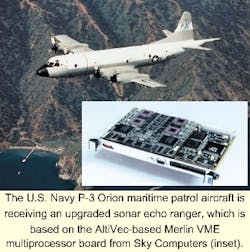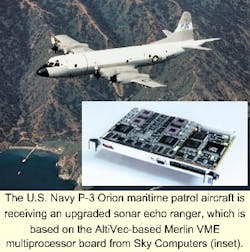Computers
When engineers at the Baltimore-based Second Order Systems Group needed to upgrade the radars on the U.S. Navy's fleet of P-3C Orion anti-submarine warfare aircraft, they were operating under a tight deadline and had to have the embedded computers immediately.
They turned to Sky Computers Inc., Chelmsford, Mass., which did provide immediate delivery, says Ash Law, the program manager at Second Order Systems. The other vendors quoted delivery in November 2000. Second Order specializes in real-time data acquisition and processing.
The system is an airborne sonar echo ranger that the P-3 crews use to determine the range to a target from signals received by deployed sonobuoys. The complete system consists of three of Sky's Merlin VME multiprocessor boards plus a slot controller, A-D and D-A converters - all commercial off-the-shelf (COTS) parts - plus the company's own custom-designed high-speed serial interface that converts the radio frequencies to digital data for input into the SKYchannel interconnect.
This approach essentially amounts to one less board per system, Ash says, and saves Second Order Systems about $40,000 per system. The Navy plans to install the upgrade in all 50 of the aircraft in its Orion fleet.
The heart of the system is the G4 Merlin boards that Sky introduced last year. The new Merlin is based on the new AltiVec MPC7400 PowerPC microprocessor, which performs digital signal processing (DSP) functions without the programming complexity usually required for DSP chips, particularly for large, complex algorithms.
The devices also feature single-instruction multiple-data multiprocessing capability, and can be simple drop-in replacements to existing PowerPC 750 units, says Steve Paavola, product marketing manager at Sky.
The Navy's rationale in upgrading the sonar is to detect more threat, Paavola adds. The new technology permits this to be done with the same aircraft crew size. The software compatibility with previous hardware also cuts development time with what he calls a "recompile and run" approach.
Now, Sky is looking for other applications on platforms with less demanding environments (aircraft based on commercial models rather than fighter aircraft, for example) and is working with BAE Systems (the merged British company of British Aerospace and Marconi Electronic Systems) for a similar naval surveillance application.
The approach would be to replace six chassis of proprietary hardware to one VME chassis of COTS PowerPC microprocessors. The software is written in a portable, high-level version of the C language. -J.R.
For more information, contact Sky Computers Inc. by phone at 978-250-1920, by fax at 978-250-0036, by mail at 27 Industrial Way, Chelmsford, Mass. 01824, or on the World Wide Web at www.skycomputers.com.
null




